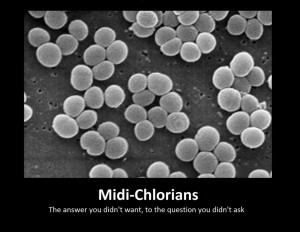
…The boy nodded his understanding. “Can I ask you something?” The Jedi Master nodded. “What are midi-chlorians?” Wind whipped at Qui-Gon’s long hair, blowing strands of it across his strong face. “Midi-chlorians are microscopic life-forms that reside within the cells of all living things and communicate with the Force.”…
…”Use the Force, Luke.”…
…Raistlin lifted his thin, frail hand and allowed the spell component he had taken from his pouch to fall slowly from between his fingers onto the deck of the boat. Sand, Tanis realized. “Ast tasarak sinuralan krynawi,” Raistlin murmured, and then moved his right hand slowly in an arc parallel to the shore….
…”The One Power,” Moiraine was saying, “comes from the True Source, the driving force of Creation, the force the Creator made to turn the Wheel of Time.”…
Bibbidi, bobbidi, boo.
There seem to be almost as many ways of representing magic as there are fantasy writers. Role-players know the whole system with mages, spell components, spellbooks, the language of magic, etc. Jordan fans can tell you the ins and outs of the One Power, complete with a discourse on the varying characteristics of saidar and saidin, and the innumerable levels of strength among Aes Sedai. And Star Wars geeks (a word I use with love, considering that I myself am a dyed-in-the-wool geek!) were stunned when Lucas started explaining the universe-balancing Force with microscopic middlemen, instead of with the innate power of Luke Skywalker and Darth Vader. What ties them in common is that they each have a system, a framework with rules and laws almost more complicated than those of physics. Mages lose their spells after one casting, and must rest and recommit the words to memory before casting again. Aes Sedai spend years in training, because abuse of the One Power can too easily lead to death… and evidently you’ve got to be well-stocked on single-celled symbionts (is that even a word? My spellchecker sure doesn’t like it) to even make a dent in the Force. Fantasy writers delight in coming up with their own, hopefully brand-new systems, to give their books that added twist, that spark that no other sword-swinging Elf-hopping kender-singing dragon-flying books have. But what about Tolkien? Where is the system? What are the rules which govern the making of Rings of Power, which delineate the powers and limits of Istari, of Maiar, of Valar? He never talks about a framework or physical laws; we only see the results of the power’s use. Where does the power come from?
Continue reading “Tolkien and Magic: The Power of Individuality”


